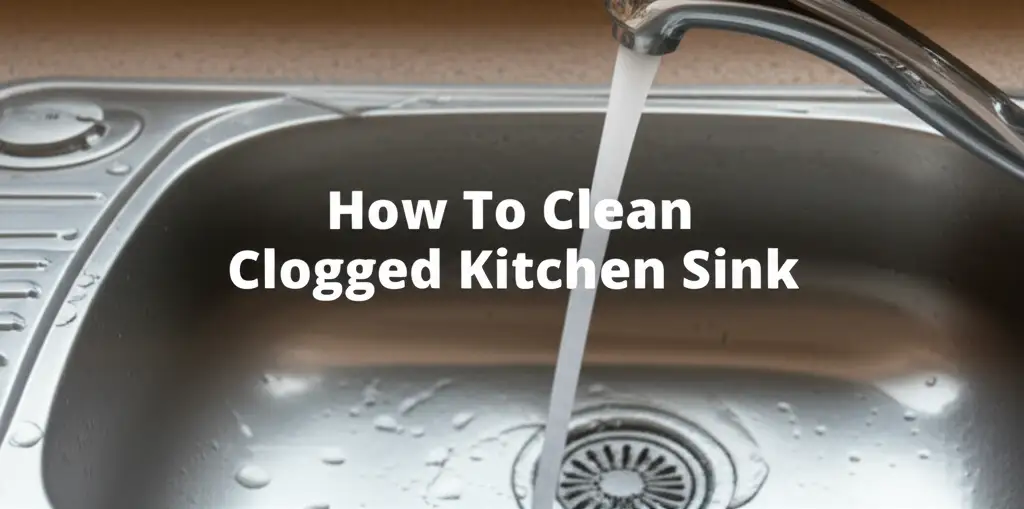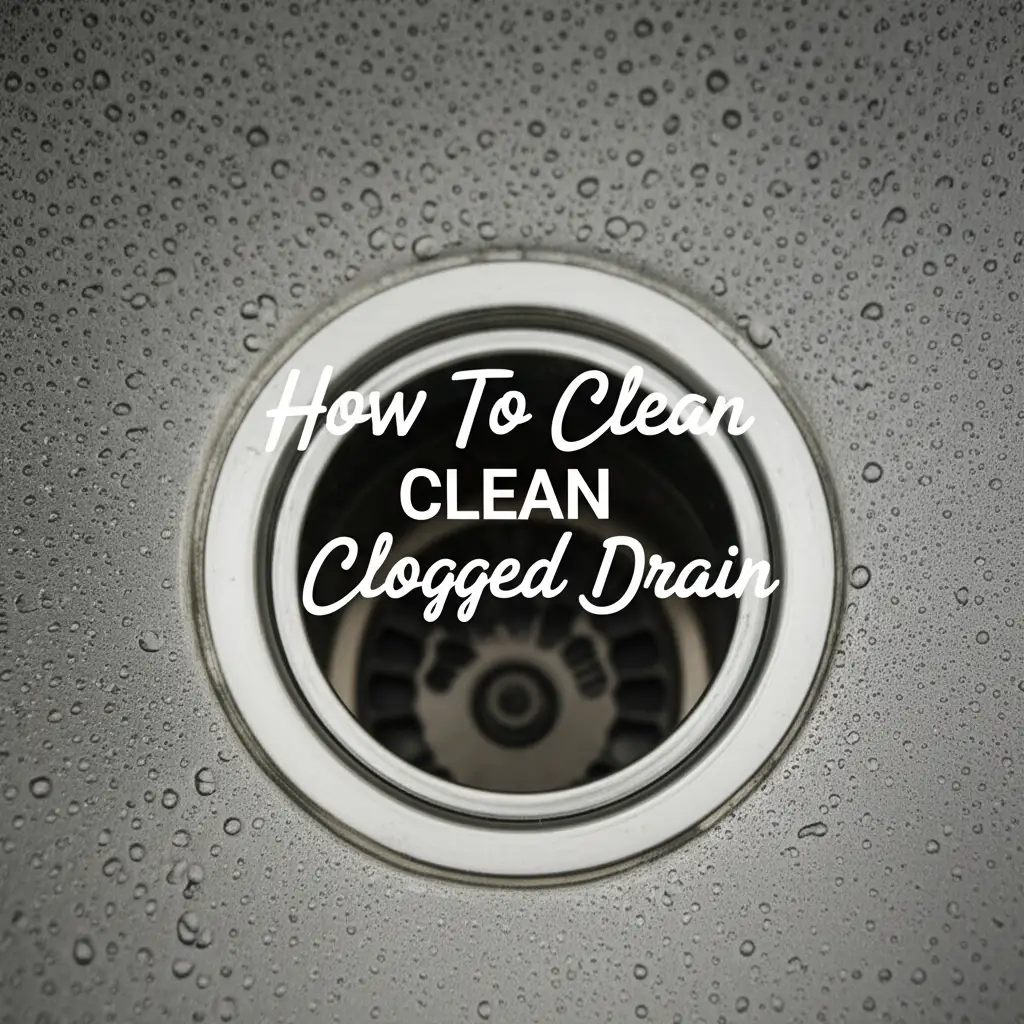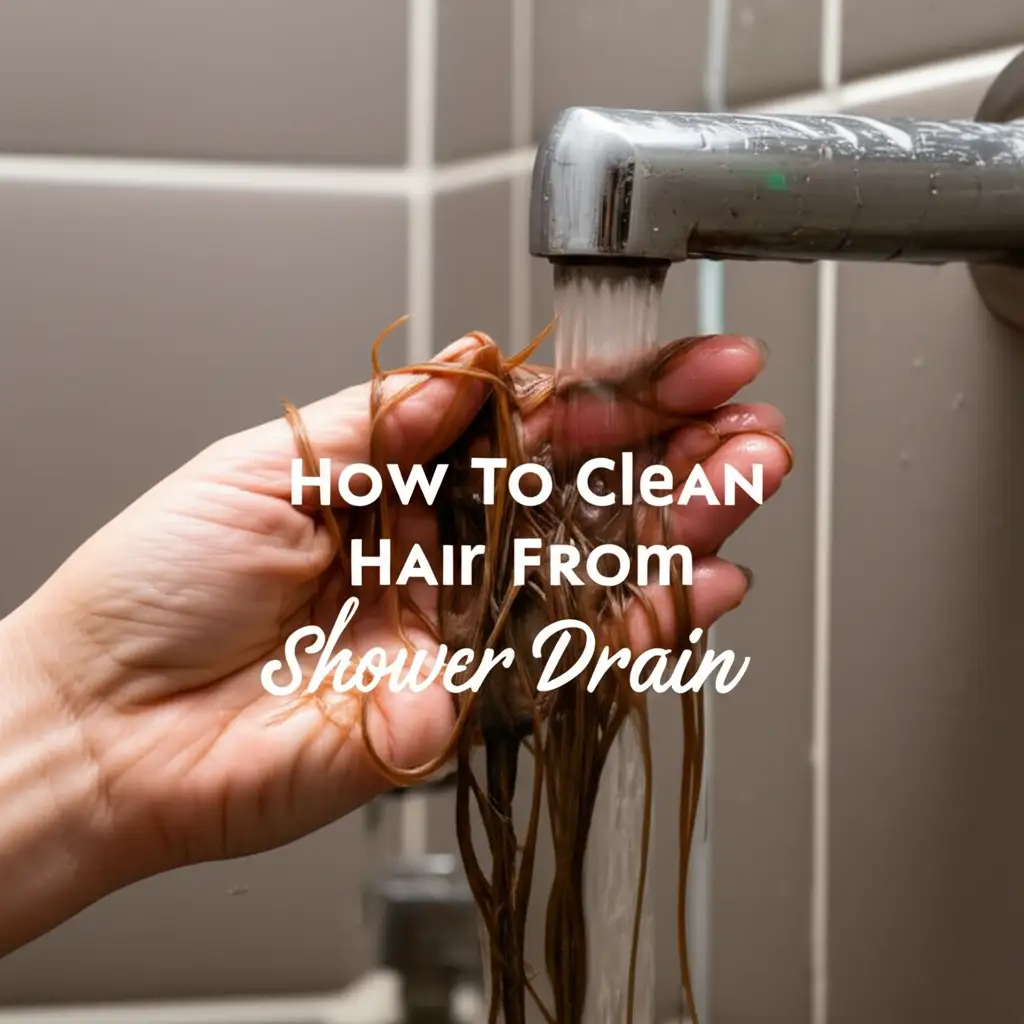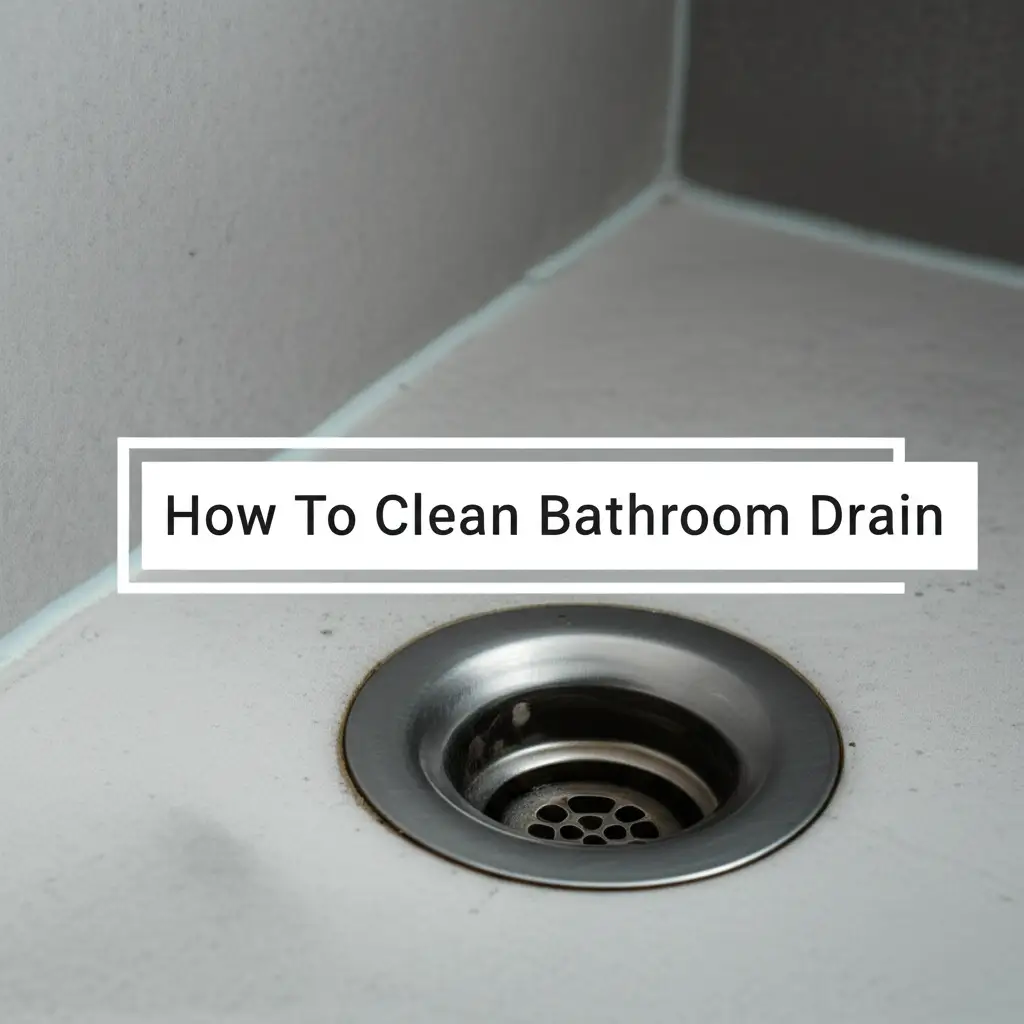· Home Cleaning, Kitchen Maintenance, Plumbing · 17 min read
How To Clean Clogged Kitchen Sink

How to Clean a Clogged Kitchen Sink Easily
That annoying gurgle or slow drain is never a welcome sound in your kitchen. A clogged kitchen sink disrupts your daily routine. It makes washing dishes or preparing meals a real chore. I understand the frustration it brings.
You are not alone in facing this common household problem. Many factors contribute to these blockages. The good news is that you often can fix a clogged kitchen sink yourself. You do not need to call a plumber right away. I will guide you through simple, effective methods. We will start with easy DIY fixes. We will move to more involved solutions. By the end, you will know how to clean your kitchen sink drain. You will also learn how to keep it clear in the future.
Takeaway
- Cleaning a clogged kitchen sink often involves simple tools and household products.
- Start with methods like boiling water or a baking soda and vinegar solution.
- Use a plunger to dislodge many common kitchen sink blockages.
- A drain snake is effective for deeper, more stubborn clogs.
- Regular maintenance prevents future sink drainage issues.
To clean a clogged kitchen sink, start with boiling water. If that fails, try a baking soda and vinegar mixture. A plunger can dislodge many blockages. For persistent clogs, a drain snake is effective. These methods often clear common kitchen sink obstructions, restoring proper drainage.
Understanding Why Your Kitchen Sink Clogs
Kitchen sinks are busy places. They handle all sorts of things. This means they are prone to clogs. Knowing what causes a kitchen sink clog helps you fix it. It also helps you prevent it from happening again. Most blockages build up over time.
A primary culprit is grease and oil. When hot grease goes down the drain, it flows easily. As it cools, it solidifies. This sticky layer coats the inside of your pipes. It acts like a magnet for other debris. Over weeks and months, this grease layer gets thicker. It reduces the pipe’s diameter. This eventually stops water from flowing through. This is a common form of kitchen sink blockage.
Common Culprits Behind Kitchen Sink Clogs
Food particles also contribute significantly to kitchen sink clogs. Small bits of food can sneak past your drain strainer. Things like coffee grounds are particularly troublesome. They do not dissolve in water. Instead, they clump together. Rice and pasta expand with water. This expansion can create dense blockages. Even small pieces of vegetable peelings add to the problem. These particles get caught in the grease buildup. This creates a solid mass that blocks the drain. This means your water cannot get through.
Soap scum is another factor. Dish soap contains fats and oils. These can combine with hard water minerals. This creates a sticky film. This film lines your pipes. It also traps food and grease. Over time, this buildup hardens. It forms a tough obstruction. You might also find black stuff in your sink drain. This often comes from mold or mildew growing on trapped food and soap scum. Regularly cleaning your kitchen helps prevent these issues. You can also learn how to clean grease from kitchen cabinets to keep your whole kitchen spotless.
First Steps: Hot Water and Dish Soap
Before you grab tools or harsh chemicals, try simple solutions. Hot water is your first line of defense. It is surprising how often this method works. Hot water melts grease. It can loosen other soft blockages. This is a safe and easy way to start.
Start by boiling a large pot of water. Let it cool for a minute or two. You want it very hot, but not boiling. Boiling water can sometimes damage PVC pipes. Carefully pour the hot water directly down the drain opening. Pour it slowly. This allows the hot water to work on the clog. Wait 5-10 minutes. See if the water drains. If it does, follow up with more hot water. This helps flush away any remaining debris.
Adding Dish Soap for Extra Power
Dish soap enhances the power of hot water. Dish soap is designed to cut through grease. It can help break down stubborn fat deposits in your pipes. This makes it a great partner for hot water.
After pouring the hot water, add about half a cup of liquid dish soap. Let it sit in the drain for 20-30 minutes. The soap will work on dissolving the grease. After waiting, flush the drain again with hot water. Pour slowly and steadily. This combination helps lubricate the clog. It pushes it through the pipe. This method is gentle on your pipes. It is also good for the environment. This simple method can often resolve minor kitchen sink clogs. It saves you from more complex cleaning tasks. You might also be interested in learning how to clean your sink after raw chicken to maintain hygiene.
Natural Cleaners: Baking Soda and Vinegar
When hot water and soap do not work, turn to natural cleaners. Baking soda and vinegar create a powerful reaction. This reaction helps break down clogs. It is a safe and eco-friendly alternative to harsh chemical drain cleaners. This method is effective for many types of blockages.
Baking soda is a mild abrasive. It also absorbs odors. Vinegar is an acid. When mixed, they create fizzing action. This fizz helps loosen debris. It scrubs the pipe walls. The reaction breaks down grease, food particles, and soap scum. It does not harm your pipes. This makes it a great choice for a clogged kitchen sink. It also helps clean out your sink drain.
Step-by-Step Application
Here is how to use baking soda and vinegar:
- Remove Standing Water: Scoop out any standing water from the sink. You want the baking soda to directly contact the clog.
- Pour Baking Soda: Pour one cup of baking soda down the drain. Try to get as much as possible directly into the drain opening.
- Add Vinegar: Follow with one cup of white vinegar. You will hear and see fizzing. This is the chemical reaction at work.
- Cover the Drain: Quickly cover the drain opening. Use a stopper or a plate. This forces the reaction downward into the pipes.
- Wait: Let the mixture work for 30 minutes to an hour. For tough clogs, you can let it sit overnight.
- Flush with Hot Water: After waiting, flush the drain with hot water. You can boil water and let it cool slightly. Pour it slowly down the drain. This helps wash away the loosened clog.
You can repeat this process if the clog is still there. This natural method works wonders for many drain cleaning issues. It is a safer choice than corrosive chemical products. You can also use vinegar for other cleaning tasks, like learning how to clean sink drain with vinegar for general maintenance. Vinegar is also excellent for tackling mold with vinegar or cleaning your shower with vinegar.
The Plunger Method for Stubborn Kitchen Sink Clogs
When natural remedies fail, it is time for mechanical action. A plunger is a simple yet powerful tool. It creates suction and pressure. This force can dislodge many stubborn kitchen sink clogs. It works by creating a vacuum. This vacuum pushes and pulls the blockage. This helps to break it apart or move it through the pipe.
Using a plunger is straightforward. Make sure you have the right type. A good plunger creates a strong seal around the drain. This ensures maximum force on the clog. It is often the next step before considering more invasive methods. You might be surprised how effective a plunger can be.
Choosing the Right Plunger
There are two main types of plungers. You need the right one for a kitchen sink.
- Cup plunger: This is the common one for sinks. It has a flat rubber cup. It works best on flat surfaces like sink drains.
- Flange plunger: This has an extra rubber flap. It is designed for toilets. The flap fits into the toilet’s drain opening. Do not use this for a sink. It will not create a good seal.
For your kitchen sink, use a regular cup plunger. Ensure the rubber cup is flexible and in good condition. A damaged plunger cannot create the necessary suction. A proper seal is crucial for success.
Effective Plunging Techniques
Follow these steps to effectively plunge your clogged kitchen sink:
- Fill the Sink: If there is no standing water, fill the sink with an inch or two of water. This helps the plunger create a strong seal. It also transmits force to the clog.
- Seal the Overflow: If your sink has an overflow drain (a small hole near the top of the basin), cover it. Use a wet rag or stopper. This prevents air from escaping. It directs all the plunging force to the clog.
- Position the Plunger: Place the plunger cup over the drain opening. Make sure it completely covers the opening. Press down firmly to create a tight seal.
- Plunge Vigorously: Push down and pull up the plunger handle quickly and forcefully. Keep the seal intact. Do this 15-20 times. You should feel resistance. This means the plunger is working.
- Check Drainage: Remove the plunger. See if the water drains. If it does, run hot water to flush the pipe. If not, repeat the plunging process.
Sometimes, you need to repeat the plunging several times. Be persistent. This method often clears most kitchen sink blockages. If the clog remains after several attempts, it is time for the next step.
Using a Drain Snake or Hand Auger
If the plunger fails, the clog is likely deeper or more solid. This is when a drain snake (also called a hand auger) becomes necessary. A drain snake is a flexible cable. It has a corkscrew tip. You feed it into the drain. It can reach clogs far down the pipe. It breaks them apart or pulls them out.
A drain snake is a powerful tool for drain cleaning. It goes beyond what plungers can do. It is especially useful for hair, grease, or solid food particle blockages. You can rent one from a hardware store. You can also buy a basic hand auger. A basic hand auger is affordable for homeowners. It is a good investment for persistent drainage issues.
When to Use a Drain Snake
Use a drain snake when:
- Boiling water, baking soda, vinegar, and plunging have not worked.
- You suspect the clog is deep in the pipes.
- The clog is due to something solid like accumulated food debris or even a fallen object.
A drain snake helps you avoid disassembling pipes. This saves time and effort. It is a great next step before calling a professional plumber.
Step-by-Step Drain Snaking
Here is how to use a drain snake effectively:
- Prepare the Area: Place a bucket under the P-trap (the U-shaped pipe under the sink). This catches any water or debris that might spill. You might also want to wear gloves.
- Remove the Stopper: Take out the sink stopper. This gives you direct access to the drain opening.
- Insert the Snake: Feed the snake’s tip into the drain opening. Push it gently. Rotate the handle as you push. This helps the snake navigate bends in the pipe.
- Feel for Resistance: When you hit the clog, you will feel resistance. Keep rotating and pushing. The corkscrew tip will break up the clog. It can also grab onto it.
- Clear the Clog: Once you feel the clog give way, slowly pull the snake back out. Be careful. The snake might bring out foul-smelling debris. Have a towel ready.
- Flush the Drain: Run hot water down the drain. This flushes away any remaining debris. If the water drains freely, you have cleared the clog. If not, repeat the snaking process.
This method effectively clears stubborn kitchen sink clogs. It helps clear gunk out of your bathroom sink drain too. Remember to clean the snake thoroughly after use. This keeps it ready for the next time.
Cleaning the P-Trap for Major Kitchen Sink Blockages
Sometimes, the clog sits in the P-trap. This is the U-shaped pipe directly under your sink. This section of pipe is designed to hold a small amount of water. This water creates a seal. It prevents sewer gases from entering your home. It also catches heavier debris. If your sink is completely blocked, checking the P-trap is a logical next step. It is often the easiest part of the drain system to access.
Cleaning the P-trap means physically removing it. You then empty any debris inside. This might sound intimidating. However, it is a straightforward process. You do not need specialized plumbing skills. It just requires a few basic tools and a little care. This method directly tackles the most common spot for kitchen sink blockages.
What is the P-Trap?
The P-trap is a crucial part of your sink’s plumbing system. Its bent shape serves two main purposes:
- Odor Seal: The water held in the “U” bend acts as a barrier. It blocks unpleasant sewer gases from coming up into your kitchen.
- Debris Catcher: Because of its shape, the P-trap effectively traps items. These include food particles, grease, and small objects that accidentally fall down the drain. This prevents them from traveling deeper into your plumbing system. This makes the P-trap a common spot for clogs to form.
Identifying the P-trap is easy. Look under your sink. It is the U-shaped section of pipe directly below the drain basket.
Steps to Remove and Clean the P-Trap
Follow these steps to clean your P-trap:
- Prepare the Area: Clear out the cabinet under your sink. Place a bucket directly underneath the P-trap. This catches any water that will spill out. Also, have some old towels ready.
- Locate the Slip Nuts: The P-trap is usually connected to the sink tailpiece and the wall drainpipe with two slip nuts. These are large, threaded nuts you can often loosen by hand. If they are too tight, use a pair of channel-lock pliers.
- Loosen the Nuts: Carefully loosen both slip nuts. You do not need to remove them entirely. Just loosen them enough so the pipe can move.
- Remove the P-Trap: Gently pull the P-trap down and away. Be ready for water and debris to fall into the bucket.
- Clear Debris: Inspect the inside of the P-trap. Use a bottle brush or a wire to remove any collected grease, food, or other gunk. Clean the pipe thoroughly. You can rinse it with hot water in another sink or outside.
- Check Connecting Pipes: Also, look into the vertical pipe (tailpiece) coming down from the sink. Look into the horizontal pipe leading to the wall. Clear any visible debris there too.
- Reassemble the P-Trap: Place the P-trap back into position. Hand-tighten the slip nuts. Do not overtighten them, as this can crack the plastic.
- Test for Leaks: Run water into the sink. Check for leaks around the slip nuts. If you see any, tighten the nuts slightly more until the leak stops.
Cleaning the P-trap is a hands-on way to clear a clogged kitchen sink. It is effective for severe blockages. This method works well when other solutions fail. If you have an under sink water filter nearby, be careful not to disturb its connections.
Preventing Future Kitchen Sink Clogs
Cleaning a clogged kitchen sink is no fun. The best solution is prevention. Simple daily habits can keep your drain flowing freely. They also save you time, money, and hassle. A little effort each day goes a long way.
Preventative measures stop grease and food from building up. They ensure your drain pipes stay clear. This means fewer clogs. It also means less need for harsh chemicals or plumbers. I practice these steps myself. They really make a difference. Good sink maintenance keeps your entire kitchen cleaner. This includes learning how to clean your kitchen faucet spray head for optimal performance.
Best Practices for Kitchen Sink Maintenance
Here are key tips to prevent future kitchen sink clogs:
- Scrape Food Scraps: Before washing dishes, scrape all food scraps into the trash can. This includes small bits of rice, pasta, and vegetable peels. Even tiny pieces add up over time. If you have a garbage disposal, use it properly. Only put appropriate items down.
- Never Pour Grease Down the Drain: This is the most important rule. Grease, oil, and fat are major culprits for kitchen sink clogs. Pour cooled grease into an old container. You can use an empty milk carton or jar. Let it solidify. Then throw it in the trash. This prevents sticky grease from coating your pipes.
- Use Drain Screens: Place a mesh drain screen over your sink drain. These screens catch food particles before they enter the pipes. Clean the screen regularly. Empty it into the trash.
- Run Hot Water Regularly: After washing dishes, let hot water run down the drain for a minute or two. This helps flush away any remaining food bits or grease. It keeps the pipes clear.
- Flush with Boiling Water (Monthly): Once a month, pour a pot of very hot, but not boiling, water down the drain. This helps dissolve any minor grease buildup. It prevents it from becoming a major problem.
- Baking Soda and Vinegar Treatment (Monthly): Perform the baking soda and vinegar treatment once a month. This acts as a natural drain cleaner. It keeps your pipes fresh and clear. This is especially helpful if you also need to learn how to clean hard water stains from stainless steel sink to keep your sink sparkling.
By following these simple practices, you can significantly reduce your chances of experiencing a clogged kitchen sink. Prevention is always easier than fixing a problem.
Frequently Asked Questions (FAQ)
Q1: Can I use chemical drain cleaners for a clogged kitchen sink? A: I advise against using harsh chemical drain cleaners. They contain corrosive chemicals. These chemicals can damage your pipes over time. They are also dangerous to use. They pose risks to your skin and eyes. They can also create toxic fumes. Natural methods like baking soda and vinegar are much safer and often just as effective.
Q2: How often should I clean my kitchen sink drain for maintenance? A: I recommend a monthly maintenance routine. Pour hot, non-boiling water down the drain. You can also use the baking soda and vinegar method once a month. This helps prevent grease and food particle buildup. This regular cleaning keeps your drain flowing freely. It reduces the chance of future clogs.
Q3: What if none of these DIY methods work to clean my clogged kitchen sink? A: If boiling water, baking soda/vinegar, plunging, snaking, and P-trap cleaning fail, the clog might be deeper. It could be in your main line. At this point, it is best to call a professional plumber. They have specialized tools. They can diagnose and fix complex blockages.
Q4: Is a garbage disposal supposed to prevent clogs in the kitchen sink? A: A garbage disposal grinds food waste into small pieces. This helps to prevent some clogs. However, disposals can also cause clogs if misused. Avoid putting fibrous materials or large amounts of grease down the disposal. Always run plenty of cold water while using it.
Q5: How do I remove odors from my kitchen sink drain after a clog? A: Odors often come from lingering food debris or mold. After clearing a clog, flush the drain with hot water. You can then try the baking soda and vinegar treatment again. For a fresh scent, follow with lemon slices and hot water. Grind a few lemon peels in the disposal if you have one.
Q6: Do coffee grounds cause kitchen sink clogs? A: Yes, coffee grounds are a common cause of kitchen sink clogs. Many people believe they go down easily. However, they do not dissolve in water. Instead, they clump together. They can easily get stuck in existing grease or buildup in your pipes. Always dispose of coffee grounds in the trash.
Conclusion
A clogged kitchen sink is a common household nuisance. But as you have learned, you have many effective ways to tackle it. We started with simple hot water and dish soap. We then moved to powerful natural cleaners like baking soda and vinegar. For tougher blockages, we explored using a plunger, a drain snake, and even cleaning the P-trap. I am confident these methods will help you restore proper drainage to your kitchen sink.
Remember, the best defense is a good offense. Preventing future kitchen sink clogs is key. Always scrape food scraps into the trash. Never pour grease down the drain. Use drain screens. Regular maintenance with hot water or baking soda and vinegar keeps your pipes clear. Take action now. Keep your kitchen sink flowing freely. Enjoy a hassle-free home.
- kitchen sink clog
- drain cleaning
- DIY plumbing
- grease clog
- sink maintenance




